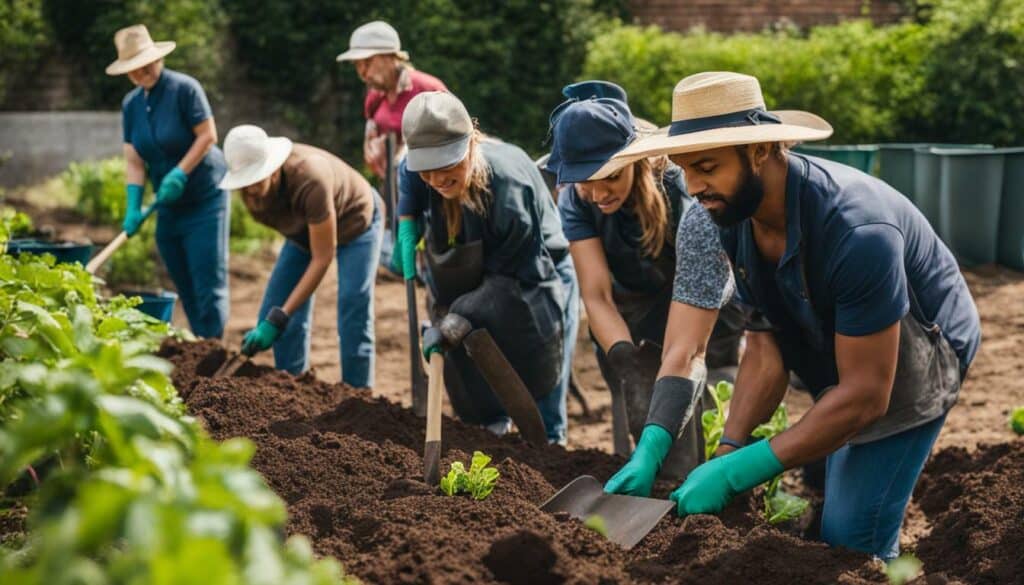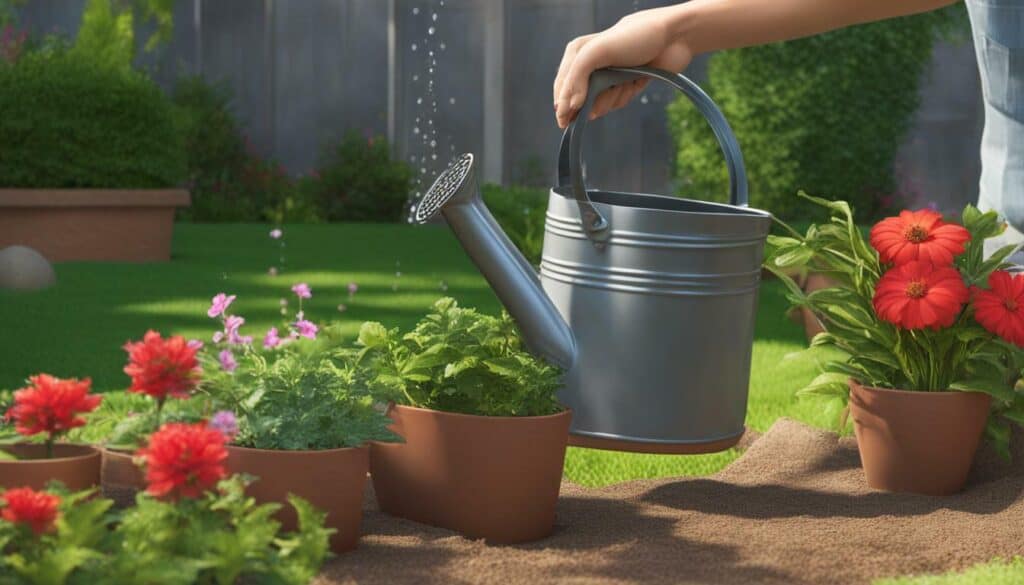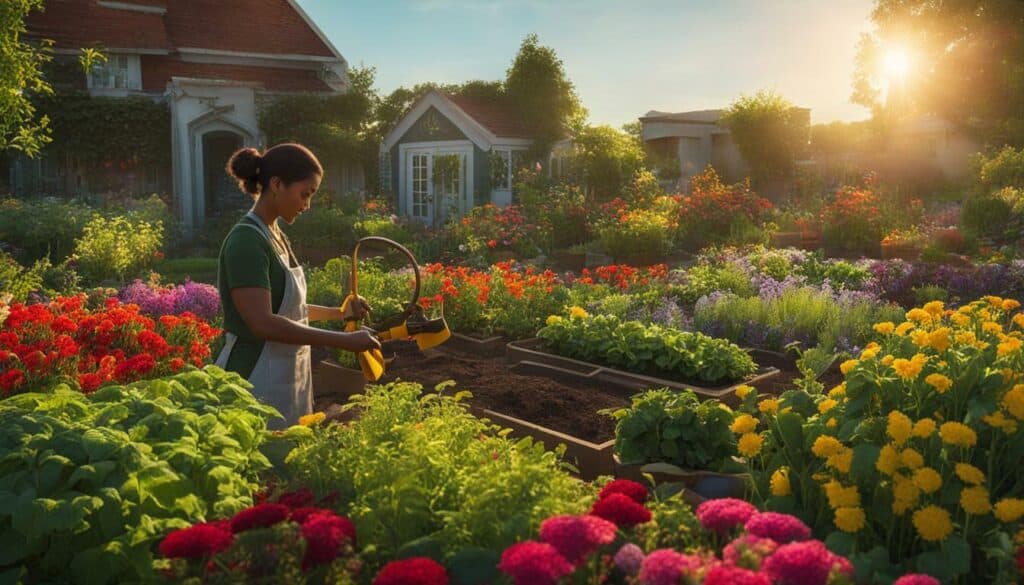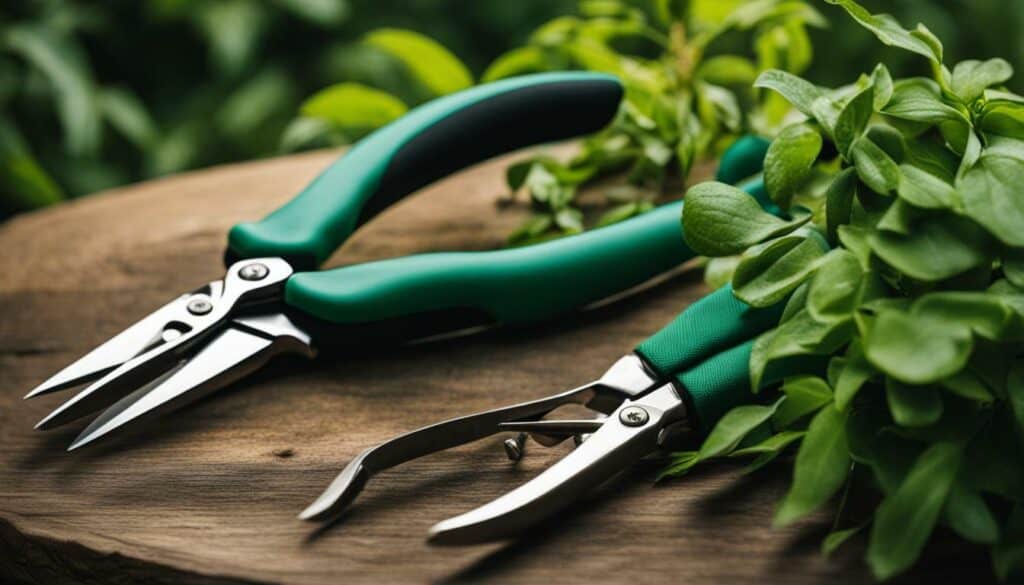Unleash Your Green Thumb with Our Garden Guides and discover the joy of gardening! Whether you’re a complete beginner or have some gardening experience, our guides will provide you with valuable tips and techniques to transform your space into a green oasis. We cover everything from selecting plants to soil testing, watering, maintenance, fertilization, pruning, and pest control. With our help, you can create a beautiful garden that suits your personal style and preferences.
Our beginner’s guide is perfect for those who are new to gardening. We’ll guide you through the basics of selecting plants suitable for beginners and help you understand the importance of soil testing and amendments. We also provide tips for involving your family in gardening, like giving children cute gardening tools and encouraging their creativity. Gardening is a journey of growth, connection, and endless possibilities. Embrace the joy and let your garden be a canvas for your family’s creativity.
Key Takeaways:
- Our garden guides provide valuable tips and techniques for gardening.
- We cover everything from plant selection to pest control.
- Our beginner’s guide is perfect for those who are new to gardening.
- Involving your family in gardening can be a fun and educational experience.
- Gardening is a journey of growth, connection, and creativity.
Choosing the Right Plants for Your Garden
When it comes to gardening, choosing the right plants is crucial for success. With our garden guides, you’ll learn how to select plants that thrive in your specific climate and soil conditions, ensuring a flourishing garden. There are different types of plants suitable for beginners, such as annuals, perennials, and biennials.
Annuals complete their life cycle in one growing season and add bursts of color to the garden. Perennials live for more than two years and come back year after year, adding beauty and structure. Biennials take two years to complete their life cycle and are more challenging to grow.
Each type of plant has specific requirements for sunlight, water, and soil conditions. Annuals prefer full sun and well-drained soil, while perennials and biennials can tolerate different light conditions and soil types. It’s important to consider these factors when selecting plants to ensure they thrive.
Preparing the soil is another crucial step in creating a successful garden. Conducting a soil test helps determine the nutrient levels and pH balance, providing insights into the soil’s health. Soil amendments, such as compost and organic matter, can be added to improve the soil’s structure, fertility, and drainage.
Soil testing is important for any gardener. It helps determine the nutrient levels and pH balance of the soil, guiding decisions about fertilizers and soil amendments. To perform a soil test, collect samples from different areas of the garden and send them to a reputable soil testing laboratory or use a DIY soil testing kit. The results will help inform decisions about amendments and fertilization practices.
Compost, manure, peat moss, and leaf mold are common soil amendments used to improve soil quality. Compost improves soil structure and provides essential nutrients. Manure adds nutrients and improves soil structure but should be well-aged or composted before use. Peat moss enhances water retention and adds organic matter, while leaf mold improves soil structure and adds organic matter, especially helpful for heavy clay soils.
Choosing the right plants and preparing the soil are essential for successful gardening. It’s a journey of growth, connection, and endless possibilities. Gardening is not just a hobby but a way to bond as a family, nurturing a love for nature and teaching valuable lessons about growth and responsibility. With the right plants and proper soil preparation, your garden can flourish and become a vibrant canvas of nature’s wonders. Happy gardening!
Preparing the Soil for Planting
Before you start planting, it’s essential to prepare your soil properly. Our garden guides will walk you through the process of conducting soil testing, making necessary amendments, and creating the ideal soil conditions for your plants to thrive.
Soil testing is an important first step to determine the nutrient levels and pH balance of your soil. This information will help you make informed decisions about soil amendments. Adding compost and organic matter can help improve soil structure and fertility, while other amendments such as lime or sulfur can adjust pH levels.
It’s also crucial to ensure good drainage in your garden soil. If the soil doesn’t drain well, plant roots can become waterlogged and suffer from oxygen deprivation. This can lead to stunted growth, disease, or even death. To improve drainage, you may need to add sand, perlite, or other materials to your soil.
When amending your soil, be sure to consider the specific needs of your plants. For example, some plants prefer a more acidic soil, while others thrive in alkaline conditions. Soil testing can help you determine the ideal pH range for your plants.
By following our garden guide’s advice for preparing your soil, you’ll help ensure your plants have the best possible start for healthy growth and productive yields.

Mastering Watering Techniques
Watering your garden correctly is key to its overall health and vitality. With our garden guides, you’ll learn the best watering techniques to ensure your plants receive the right amount of moisture for optimal growth.
It’s important to understand the specific watering needs of different types of plants. Some plants, like succulents, require infrequent but deep watering, while others, like vegetables, need consistent moisture. To avoid over or under-watering, it’s essential to know the specific requirements of the plants in your garden.
Preparing the soil before planting is also crucial for proper plant growth. Conducting soil tests and using soil amendments, such as compost and organic matter, can improve soil fertility, structure, and drainage. Healthy soil will retain moisture better, reducing the need for frequent watering.
Proper drainage is also essential for healthy plant growth. Overwatering can cause root damage and fungal growth, leading to plant disease and death. Good drainage, achieved through proper soil preparation and the use of raised beds or containers, can help prevent these issues.
When watering your garden, it’s important to water deeply and infrequently, allowing the water to soak into the soil rather than evaporating on the surface. Water in the early morning or late evening to avoid excessive evaporation and reduce the risk of plant disease.
With these tips and techniques, you can become a master gardener and ensure your garden thrives. Remember to always check the specific watering needs of your plants and adjust your watering schedule accordingly.

Essential Maintenance Tips
Maintaining your garden is a crucial part of gardening success. In our garden guides, you’ll find valuable maintenance tips to help you keep your plants healthy, control weeds, and improve overall garden aesthetics. To get started, consider the following:
- Choose the right plants for your garden based on their specific requirements such as sunlight, water, and soil conditions. Annuals are perfect for bursts of color, perennials provide long-lasting beauty, and biennials offer an exciting challenge. By selecting the right plants, you can ensure they thrive in your garden.
- Prepare your soil by conducting a soil test to determine nutrient levels and pH balance. Use soil amendments like compost, organic matter, and sand to improve soil structure, fertility, and drainage. This will create a fertile foundation for your plants to grow and flourish.
- Water plants using proper techniques and perform regular maintenance tasks such as fertilization, pruning, and pest control to keep your garden thriving. Proper watering techniques will help avoid over or under-watering, while fertilizing, pruning, and pest control will promote plant health and growth.
- Involve your family in gardening and provide them with kid-friendly tools to cultivate a love for nature and teach them about growth and responsibility. Gardening can be a fun and educational family activity that promotes bonding and learning about the natural world around us.
- Gardening is a journey of growth, connection, and creativity. Embrace the joy and magic of gardening by exploring different plant varieties, experimenting with garden design, and creating a vibrant tapestry of nature’s wonders in your own backyard.
“The love of gardening is a seed once sown that never dies.” – Gertrude Jekyll
By following these essential maintenance tips, you can unleash the full potential of your garden and enjoy a beautiful and thriving outdoor space. Happy gardening!
The Art of Fertilization
Fertilization plays a vital role in nourishing your plants and promoting healthy growth. With our garden guides, you’ll discover the art of fertilization, including the different types of fertilizers available and how to apply them effectively.
Before fertilizing, it’s important to conduct a soil test to determine any nutrient deficiencies or excesses. Soil amendments, such as compost, manure, peat moss, and leaf mold, can improve soil fertility, structure, and overall health, leading to healthier plant growth.
| Type of Fertilizer | Benefits | Application Method |
|---|---|---|
| Organic Fertilizer | Slow-release, improves soil structure, promotes soil microbe growth | Apply to the soil surface and water in, or mix in with the soil before planting |
| Synthetic Fertilizer | Fast-release, concentrated nutrients and minerals | Apply in small doses to avoid over-fertilization |
When applying fertilizer, it’s important to follow the instructions on the label and to avoid over-fertilizing. Too much fertilizer can lead to chemical burn, root damage, and nutrient imbalances.
By mastering the art of fertilization, you can ensure the optimal health and growth of your garden. Our garden guides can help you achieve a thriving and beautiful garden, with lush foliage, colorful blooms, and healthy fruits and vegetables.

Gardening is not just for adults – it can be a fun and educational adventure for children as well. By involving children in gardening, they can learn valuable lessons about growth, responsibility, and the wonders of nature.
So why not embark on a gardening journey with our expert garden guides, and embrace the beauty and creativity of nature. From soil preparation to plant care and pest control, our guides can help you unleash your green thumb and transform your outdoor space into a flourishing garden.
Pruning Techniques for a Beautiful Garden
Pruning is an essential gardening technique that not only improves the appearance of your plants but also promotes their overall health. Our garden guides will teach you the proper pruning techniques for a beautiful and thriving garden.
Timing is crucial when it comes to pruning. Most plants should be pruned during their dormant season, which is typically in late winter or early spring. However, flowering shrubs should be pruned immediately after they bloom to avoid cutting off next year’s flower buds. It is also important to use sharp and clean pruning tools to prevent damage or disease.
To start, remove any dead or diseased branches to prevent the spread of disease and allow for better air circulation and light penetration. Shaping plants is also important and can involve cutting back long shoots or trimming plants into a specific form or structure. Thinning overcrowded branches will improve air circulation and sunlight penetration, preventing diseases like powdery mildew and promoting healthy growth of new shoots.
For older shrubs or trees, consider renewal pruning to rejuvenate them. This involves removing one-third of the oldest, unproductive stems each year to stimulate new growth from the base. Timing is also important for flowering plants, as pruning spring-blooming plants right after they bloom will ensure they set their flower buds on the previous year’s growth. Summer-blooming plants can be pruned in late winter or early spring before new growth begins.
Finally, for fruit trees, pruning can improve fruit production and maintain a manageable size. Removing dead wood, thinning branches to allow sunlight in, and shaping the tree to an open center or modified central leader structure are all effective techniques.
Remember that each plant has different pruning requirements, so it is essential to research specific plants or consult gardening resources for more detailed guidance. By mastering these pruning techniques, you can create a beautifully shaped and healthy garden that will be the envy of your neighbors.

Pest Control for a Pest-Free Garden
Dealing with pests in your garden can be a challenge, but with our garden guides, you’ll learn effective pest control methods to protect your plants and keep your garden thriving. As with any type of gardening, choosing the right plants for your garden is crucial, especially for beginners. Annuals, perennials, and biennials each have their own specific requirements, and it’s essential to choose plants that are suited for your climate and soil type.
Preparing the soil before planting is also crucial. Conducting a soil test can determine nutrient levels and pH balance. Adding soil amendments such as compost, manure, peat moss, and leaf mold can help improve soil structure and nutrient content, while good drainage is also essential for healthy plants.
Maintaining your garden is also important, with tasks such as watering, fertilization, pruning, and pest control being key factors in keeping your garden thriving. Regular pruning, weeding, and mulching can help promote plant health, while organic pest control solutions can help keep your garden free from harmful insects and diseases.
Getting children involved in gardening can be a fun and educational family activity. Engage them with mini gardening tools and teach them about nature and responsibility as the garden flourishes. As the garden grows, so does the bond within the family.
Gardening is not just a hobby, but a journey of growth, connection, and endless possibilities. With the right techniques and knowledge, anyone can unlock the secrets of their green thumb and embrace the joy and magic of nature.
Gardening as a Family Activity
Gardening is not just a solitary activity – it can be a wonderful opportunity to bond with your family and create lasting memories. Our garden guides will show you how to involve children in gardening and make it an enjoyable and educational experience for everyone.
Choosing the right plants for beginners is crucial for a successful garden. It’s important to understand the sunlight, water, and soil requirements of each plant. Our garden guides offer plant care advice to help you make the right choices.
Preparing the soil is another crucial step in creating a successful garden. Soil testing is important to determine the nutrient levels and pH balance. Adding soil amendments like compost, manure, peat moss, and leaf mold can improve soil fertility and structure.
Involving children in gardening with their own gardening tools is an excellent way to cultivate a love for nature and teach them about growth and responsibility. Our garden guides offer tips for involving children and making it a fun and educational family activity.
Gardening is not just a hobby; it is a journey of growth, connection, and endless possibilities for the whole family to enjoy and bond over.
Embrace gardening as a family activity and create your own green oasis. Our garden guides provide the knowledge and tools to help your family create a beautiful and sustainable garden that everyone can enjoy.
Embracing Gardening as a Journey
Gardening is more than just a hobby; it’s a journey of personal growth, connection with nature, and creative expression. With our garden guides, we invite you to embrace the joys of gardening and experience the countless rewards it offers.
Choosing the right plants for your garden is a crucial first step in your gardening journey. As a beginner, opt for easy-to-grow plants such as annuals, perennials, or biennials that are compatible with your climate and soil. Understanding the specific requirements of your plants for sunlight, water, and soil conditions is essential for their healthy growth.
Preparing the soil is equally important in creating a thriving garden. Soil testing can provide valuable insights into the soil’s nutrient levels and pH balance, allowing you to choose the right soil amendments such as compost, manure, peat moss, or leaf mold, to improve soil fertility and structure in preparation for your plants.
Gardening involves a continuous process of nurturing, and our garden guides provide expert tips on watering techniques, maintenance, fertilization, pruning, and pest control to keep your garden looking beautiful and healthy. Involving children in gardening can foster their love for nature and help them learn about growth and responsibility.
Gardening is more than just a hobby. It is a journey of personal growth, connection, and endless possibilities. As you tend to your garden and watch it grow, you’ll experience the satisfaction and fulfillment that comes with nurturing and creating something beautiful.
Let our garden guides be your trusted companions on this journey of growth and discovery. Together, let’s create a vibrant tapestry of nature’s wonders and enjoy the countless rewards of gardening!

Transforming Your Garden with Creative Designs
A well-designed garden is a true work of art that reflects your personality and enhances the beauty of your home. Our garden guides will inspire you with creative designs and landscaping ideas to transform your garden into a stunning oasis.
Choosing the right plants is the foundation of any beautiful garden. From colorful annuals to majestic perennials and intricate biennials, there are many options to suit your taste and skill level. Imagine a flower bed bursting with vibrant colors or a vegetable patch brimming with fresh produce.
Preparing the soil is crucial to ensure a thriving garden. Testing the soil’s nutrient levels and pH balance can provide valuable insights for improving its overall health. Adding soil amendments, such as compost, organic matter, and sand, can enhance its fertility, structure, and drainage.
Planting your seeds or seedlings correctly is essential for their growth. A proper understanding of spacing, depth, and watering techniques ensures that your plants have the best start in life. Ongoing care, including watering, maintenance, fertilization, pruning, and pest control, will keep your garden thriving throughout the growing season.
Gardening is a wonderful family activity that cultivates closer bonds and provides a fun and educational experience for children. Children’s gardening tools can be used to teach them about nature, responsibility, and growth. With their creativity and curiosity, children can turn your garden into a magical wonderland.
Embrace the joy and magic of gardening to transform your garden into a canvas for your family’s creativity. Whether you seek a tranquil haven or a lively gathering place, our garden guides offer endless possibilities for your green thumb. Happy gardening!

Conclusion
Gardening is a rewarding and fulfilling journey that connects us with nature, brings beauty to our surroundings, and provides an outlet for creativity. With our garden guides, you have the knowledge and tools to unleash your green thumb and create a thriving garden that brings joy to your life.
Choosing the right plants for your garden is crucial, whether you opt for annuals, perennials, or biennials. Preparing the soil is another essential step, which involves soil testing to determine nutrient levels and pH balance, as well as adding soil amendments such as compost, manure, peat moss, or leaf mold to improve soil fertility and structure.
Gardening also requires ongoing care, including watering techniques, maintenance tips, fertilization, pruning, and pest control. By following our garden guides, you’ll have the knowledge to keep your plants healthy and flourishing.
Beginners and families can get involved in gardening, as it not only nurtures plants but also fosters creativity, responsibility, and a connection to nature. So, gather your loved ones, roll up your sleeves, and start digging!
Overall, gardening is a fulfilling pursuit that can bring joy, laughter, and a touch of magic to your family’s life. Embrace the journey, experiment with different plants and designs, and let your garden be a reflection of your unique personality and style.
FAQ
Q: What topics do the garden guides cover?
A: The garden guides cover various aspects of gardening for beginners, including choosing plants, preparing soil, conducting soil testing, using soil amendments, watering techniques, maintenance tips, fertilization, pruning, pest control, involving children in gardening, and embracing gardening as a journey of growth and creativity.
Q: How do I choose the right plants for my garden?
A: When choosing plants for your garden, consider your climate, soil type, and personal preferences. It’s important to select plants that are suitable for your specific growing conditions to ensure their success and longevity.
Q: What should I do to prepare the soil for planting?
A: To prepare the soil for planting, conduct soil testing to determine its pH level and nutrient content. Use soil amendments such as compost or organic matter to improve fertility and texture. Creating a fertile foundation will provide a nutrient-rich environment for your plants to thrive.
Q: How can I master watering techniques for my garden?
A: Proper watering techniques are essential for a healthy garden. Water your plants at the right time and in the right amount to avoid over or under-watering. Monitor soil moisture levels and adjust your watering schedule accordingly.
Q: What are some essential maintenance tips for my garden?
A: Regular maintenance tasks such as pruning, weeding, and mulching are important for keeping your garden looking its best. Pruning promotes plant health and aesthetics, while weeding and mulching help control weeds and retain soil moisture.
Q: Why is fertilization important for my plants?
A: Fertilizing your plants provides them with essential nutrients for optimal growth. Different types of fertilizers, application methods, and frequency of use can be employed to ensure your plants receive the proper nourishment they need.
Q: How can I effectively prune my plants?
A: Pruning is important for maintaining plant health and aesthetics. Learn when and how to prune different types of plants to promote growth, shape, and flowering. Proper pruning techniques will help your plants thrive.
Q: How can I control pests in my garden?
A: To keep your garden pest-free, practice preventative measures, such as removing debris and attracting beneficial insects. Identify and address pest problems early and consider organic pest control solutions to minimize harm to the environment.
Q: How can gardening be a family activity?
A: Gardening can be a fun and educational family activity. Involve children in planting, watering, and caring for plants. Teach them about the importance of nature, sustainability, and the joy of watching plants grow.
Q: What are the broader benefits of gardening?
A: Gardening is a journey of personal growth, connection, and creativity. It offers a sense of fulfillment, satisfaction, and an opportunity to connect with nature. It allows for personal expression through design and landscaping ideas.
Q: How can I transform my garden with creative designs?
A: Explore garden design and landscaping ideas to transform your outdoor space. Incorporate elements such as pathways, seating areas, colorful plants, and focal points to create a beautiful and functional garden that reflects your personal style.
Can Beginners Successfully Create and Maintain a Garden with the Help of “Ultimate Guide to Gardens for Dummies: Green Thumb Made Easy”?
Can beginners successfully create and maintain a garden with the help of Ultimate Guide to Gardens for Dummies: Green Thumb Made Easy? Absolutely! This comprehensive guide provides step-by-step instructions, practical tips, and valuable insights for aspiring gardeners. With its user-friendly approach and clear explanations, gardens for dummies made easy is the perfect resource to transform anyone into a successful gardener, regardless of their previous experience.
Source Links
- https://www.thegoodlifeonstage.com/unleash-your-green-thumb-beginners-guide-to-gardening.htm
- https://flyingtiger.com/blogs/news/green-thumb
- https://medium.com/@flyingtigercopenhagen/unleash-your-familys-green-thumb-bea0741692e8
- https://www.gardenguides.com/
- https://www.realhomes.com/advice/how-to-choose-plants-for-your-garden
- https://ag.umass.edu/landscape/fact-sheets/right-plant-right-place-plant-selection-guide-for-managed-landscapes
- https://www.thespruce.com/plant-selection-for-the-landscape-2131865
- https://www.almanac.com/soil-preparation-how-do-you-prepare-garden-soil-planting
- https://www.planetnatural.com/garden-soil/
- https://platthillnursery.com/best-tips-to-prepare-garden-soil/
- https://www.daisycreekfarms.com/blog/pguiyeniebds2pdt6oyqs63di1rlfg
- https://www.creativevegetablegardener.com/watering-vegetable-garden/
- https://www.upperstreethome.com/watering-cans-101-mastering-the-art-of-efficient-plant-watering/
- https://www.bhg.com/gardening/yard/garden-care/gardening-tips-for-every-gardener/
- https://www.housebeautiful.com/uk/garden/a585/top-tips-garden-maintenance/
- https://platthillnursery.com/guide-to-enjoyable-effective-garden-maintenance/
- https://www.bhg.com/gardening/yard/garden-care/why-you-should-fertilize-plants/
- https://gardenerspath.com/plants/vegetables/fertilize-vegetable-garden/
- https://www.thespruce.com/fertilizer-for-vegetable-garden-7567426
- https://aggie-horticulture.tamu.edu/earthkind/landscape/proper-pruning-techniques/
- https://www.finegardening.com/article/pruning-tips-and-techniques
- https://www.amazon.com/Cass-Turnbulls-Guide-Pruning-3rd/dp/1570617511
- https://abundantminigardens.com/organic-pest-control-resource/
- https://www.amazon.com/Organic-Pest-Disease-Control-Problem-Free/dp/0395813700
- https://www.amazon.com/Naturally-Bug-Free-Gardening-Beginners/dp/1500516775
- https://messymotherhood.com/beginners-guide-gardening-with-kids/
- https://thefunmaster.com/unleash-your-childs-green-thumb-the-ultimate-guide-to-gardening-fun-with-kids/
- https://naturalearning.org/gardening-activity-guide/
- https://meadowlarkjournal.com/blog/chaos-garden
- https://www.countryliving.com/uk/homes-interiors/gardens/a41775781/slow-gardening/
- https://www.vivavita.org/post/the-joy-of-gardening-how-to-embrace-outdoor-space-to-maximize-well-being
- https://www.housebeautiful.com/uk/garden/designs/a495/garden-design-ideas/
- https://melissapenfold.com/interiors/your-guide-to-the-ultimate-garden-transformation/
- https://www.amazon.com/Garden-Renovation-Transform-Your-Dreams/dp/1604696125
- https://content.ces.ncsu.edu/home-vegetable-gardening-a-quick-reference-guide
- https://www.ncbi.nlm.nih.gov/pmc/articles/PMC6334070/






Leave a Reply